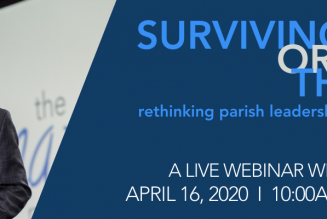By Dr. Jeff Mirus ( bio – articles – email ) | Nov 28, 2023
I am struck by how frequently our own particular preoccupations drive our analysis of everything around us. That is a good thing if our own particular preoccupation is conversion to Christ, love of the Father, and openness to the promptings of the Holy Spirit. But most of our preoccupations are colored not only by our own faulty commitments but by the unrecognized temptations which too often affect our goals and our behavior. Or, to approach this from a different point of view, the combination of our preoccupations and our gifts may make us either suitable or unsuitable for the achievement of particular goals which require, for success, abilities which go beyond mere spiritual commitment or holiness. Even personal holiness is no guarantee that any one of us is the right person for any particular task.
Let me offer two examples.
Energizing Chaplains for Christ
The first comes from Pope Francis as highlighted in our news story, Appreciate differences, accompany with care, and act courageously, Pope tells university chaplains. At a recent conference organized by the Dicastery for Culture and Education, Pope Francis encouraged university chaplains and pastoral workers “to appreciate differences, to accompany with care, and to act courageously.” He continued:
Your presence makes heard the voices of students, teachers of various disciplines, and all those whose work, often hidden, contributes to the good functioning of your educational institutions, and serves the cultures, local Churches, and different peoples, including the many young men and women, among them refugees and the poor, for whom the right to study—sadly—still remains an inaccessible privilege.
One wonders what, if anything, this means when it comes to the essential ministry of university chaplains. The eye seems more focused on institutional togetherness than on Jesus Christ. Perhaps this is not surprising, since the occasion was a conference entitled “Towards A Polyhedric Vision” (oh my!). And if we grab some of the text by which the conference organizers have described this effort, we find this:
We are at a crossroads in history, where we must reinforce our programs of university pastoral care with new methods and emphases, thereby rendering them open to what is new and to the demands of today’s cultural circumstances—that is to say, in a polyhedral way. We also need to recreate an international network of university pastoral care, at the service of a new form of solidarity among our institutions.
Do you know what this means? It means that the authors of both these statements reflect a vision of reality—most likely committee-driven—which arises more from bureaucracy than from holiness. Of course, even if it was a straight shot from holiness, holiness alone would not be sufficient to make the resulting tactics effective for their purpose. For that, you need not only proper goals and suitable means but practical ability at effectively connecting the two. Nonetheless, the absence of such requirements for effectiveness does not stop anyone from thinking and speaking in high-sounding (polyhedral?) terms—without staking any real claim for Jesus Christ at all.
Sadly, this may well be the purpose of most “conferences”—a way to discuss, listen, become known to others, and produce an illusion of achievement. When I was a boy, the father of one of my close friends would have said: “Polyhedral, my foot.” If your only tool is secular group-think, then everything begins to look like fodder for blather.
Holiness
The other example has at least a far nobler purpose. Michael J. Carroll, a profound student of the three stages of the spiritual life (the Purgative Way, the Illuminative Way, and the Unitive Way), recently sent me his book Vatican II and the Hermeneutic of Deification (2023), which had been previously published in 2020 as The Ascent of Man to God: Answering the Vatican II Period, the Doctrine of Acquiring Christian Perfection, and the Universal Call to Holiness. It is Carroll’s thesis that the universal call to holiness, specifically in the form of the three stages, can be found repeatedly in the writings of the popes of the twentieth-century and the texts of the Second Vatican Council.
In reality, Carroll seems to find them most in the works of his favorite writers, such as the key saints who contributed to the understanding of the ascent of the soul to contemplation, and in such great Catholic thinkers as St. Thomas Aquinas, St. John Henry Newman, and the notable pre-Vatican II theologian and spiritual writer Réginald Garrigou-Lagrange. But there is no question that the twentieth-century popes prior to the Council paid close attention to the need for holiness, and no question that the “universal call to holiness” was a conciliar theme—and there is also no question that this core value of holiness has largely been swept aside as irrelevant in the various efforts to “renew the Church” in the 58 years since the Council’s close.
It is Carroll’s thesis, then, that “the answer to the Vatican II period” is the one answer that has most frequently been ignored, namely the call to holiness for each and every Catholic and each and every person who inquires into Catholicism and seeks to enter the Church. Therefore, a strong focus on this theme is more than warranted.
The problem here, as is so often the case, is a kind of tunnel vision which fails also to see that not all efforts at authentic renewal are directly aimed at the individual spiritual life. There is also a need for renewal of leadership, structures, methods, and forms in ways that (one hopes) will more clearly communicate, support and sustain holiness of thought, word and deed throughout the Church, and in the relationship between the Church and both the souls and the social order which surround her. This takes not only the rise to holiness but effectiveness in methods, and the personal prudential gifts to connect the two in the service of souls.
That the universal call to holiness is a hallmark of the Council cannot be denied. That this has been largely ignored by those who claim that the purpose of the Council was this, that, or the other thing (which the Council never actually addressed in the documents it promulgated) cannot be denied either. Thus, to present this book originally as “an answer to the Vatican II period” is culturally apt. The missing ingredient in the application of the Council to the ongoing life of the Church is, perhaps most often, the Council’s call to holiness.
Unfortunately, Carroll’s work is rather convoluted and so peppered with charts and tables and quotations from his favorite references that the search for a clear explication of his thesis becomes bewildering. Despite the real value in this energetic and comprehensive work, the reader does end with the impression that the author’s only tool is his theory, and so everything must be appropriated to illustrate it, whether it has a clear bearing on the totality of the Conciliar texts or not. The (somewhat chaotic) work as originally published may be purchased on Amazon: The Ascent of Man to God (427pp).
Conclusion
For those interested in tracing the quintessentially Catholic understanding of the three stages of spiritual growth as background to a proper understanding of the Conciliar emphasis on the universal call to holiness, I can recommend Carroll’s book. In it, with patience, you can find clear indications of this spiritual core documented in at least six of the Vatican II documents, as well as in the writings of the popes and other important Catholic thinkers who preceded and followed the Council. This spiritual core has been largely neglected—amazingly enough—by most of those who prattle on about “the spirit of the Council”.
But it is also true that even those popes who have understood these spiritual connections have not made it a high priority to frame the work of the Council in accordance with this hermeneutic. A pastoral council must invariably focus to a significant degree on practical organizational matters, and these are not to be neglected. Above all, I think, Carroll intends his work as a corrective to the endless wrangling over policies and procedures and attitudes in the post-conciliar Church, wrangling invariably led by those who, preferring human fashion of one sort or another, have ignored what ought to lie at the spiritual core.
Unlike my first example of the hammer and the nail in this essay, Carroll’s book is not to be taken lightly. But the thesis does merit an author who is a clearer and more concise communicator—and a bit more open to the complexity of the conciliar task. It is true that holiness is always ground zero. But human holiness also requires its own varied contexts. It is certainly priority one, but it is not the only thing needed to answer “the Vatican II period”. Along the way, we still need a large dose of basic human competence guided by genuine human prudence.
Sound Off! CatholicCulture.org supporters weigh in.
All comments are moderated. To lighten our editing burden, only current donors are allowed to Sound Off. If you are a current donor, log in to see the comment form; otherwise please support our work, and Sound Off!

There are no comments yet for this item.









